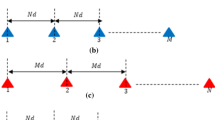Abstract
In this paper, we consider the problem of DOA estimation for a mix of incoherent and coherent targets by using the monostatic co-prime MIMO array with N sparse transmitting sensors and \(2M-1\) sparse receiving sensors. The co-prime MIMO array generates a non-redundant and uniform sub sum co-array with \({\text {O}}(MN)\) contiguous sensors using only \({\text {O}}(M+N)\) physical sensors. Based on the concept of sum co-array equivalence, we can obtain different configurations of virtual MIMO arrays with \({\text {O}}(MN)\) contiguous virtual sensors, and then construct the corresponding virtual data matrices, which provides different tradeoffs between the number of resolvable targets and the maximum number of mutually coherent targets that can be resolved. On the basis of the virtual data matrix and the conventional DOA estimation approaches such as MUSIC, \({\text {O}}(MN)\) mixed coherent and incoherent targets can be resolved only with \({\text {O}}(M+N)\) physical sensors, namely the number of resovable targets exceeds the limitation of the number of physical sensors. Finally, simulation results demonstrate the effectiveness of the proposed DOA estimation method with the monostatic co-prime MIMO array in the presence of both the coherent and incoherent targets.
Supported by National Natural Science Foundation of China under Grant 61501062, 41574136 and 41304117, and Scientific Research Foundation of the Science and Technology Department of Sichuan Province under Grant 2018GZ0454.
Access this chapter
Tax calculation will be finalised at checkout
Purchases are for personal use only
Similar content being viewed by others
References
BouDaher, E., Ahmad, F., Amin, M.G.: Sparsity-based direction finding of coherent and uncorrelated targets using active nonuniform arrays. IEEE Sig. Process. Lett. 22(10), 1628–1632 (2015). https://doi.org/10.1109/LSP.2015.2417807
BouDaher, E., Jia, Y., Ahmad, F., Amin, M.G.: Direction-of-arrival estimation using multi-frequency co-prime arrays. In: 2014 22nd European Signal Processing Conference (EUSIPCO), pp. 1034–1038, September 2014
BouDaher, E., Jia, Y., Ahmad, F., Amin, M.G.: Multi-frequency co-prime arrays for high-resolution direction-of-arrival estimation. IEEE Trans. Sig. Process. 63(14), 3797–3808 (2015). https://doi.org/10.1109/TSP.2015.2432734
BouDaher, E., Ahmad, F., Amin, M.G.: Sparse reconstruction for direction-of-arrival estimation using multi-frequency co-prime arrays. EURASIP J. Adv. Sig. Process. 2014(1), 168 (2014). https://doi.org/10.1186/1687-6180-2014-168
BouDaher, E., Ahmad, F., Amin, M.G.: Sparsity-based DOA estimation of coherent and uncorrelated targets using transmit/receive co-prime arrays (2015). https://doi.org/10.1117/12.2177597
Hoctor, R.T., Kassam, S.A.: The unifying role of the coarray in aperture synthesis for coherent and incoherent imaging. Proc. IEEE 78(4), 735–752 (1990). https://doi.org/10.1109/5.54811
Hoctor, R.T., Kassam, S.A.: High resolution coherent source location using transmit/receive arrays. IEEE Trans. Image Process. 1(1), 88–100 (1992). https://doi.org/10.1109/83.128033
Liu, C., Vaidyanathan, P.P.: Remarks on the spatial smoothing step in coarray music. IEEE Sig. Process. Lett. 22(9), 1438–1442 (2015). https://doi.org/10.1109/LSP.2015.2409153
Pal, P., Vaidyanathan, P.P.: Coprime sampling and the music algorithm. In: 2011 Digital Signal Processing and Signal Processing Education Meeting (DSP/SPE), pp. 289–294, January 2011. https://doi.org/10.1109/DSP-SPE.2011.5739227
Qin, S., Zhang, Y.D., Amin, M.G.: Generalized coprime array configurations for direction-of-arrival estimation. IEEE Trans. Sig. Process. 63(6), 1377–1390 (2015). https://doi.org/10.1109/TSP.2015.2393838
Qin, S., Zhang, Y.D., Amin, M.G.: Doa estimation of mixed coherent and uncorrelated targets exploiting coprime mimo radar. Digit. Sig. Process. 61, 26–34 (2017). https://doi.org/10.1016/j.dsp.2016.06.006. Special Issue on Coprime Sampling and Arrays
Schmidt, R.: Multiple emitter location and signal parameter estimation. IEEE Trans. Antennas Propag. 34(3), 276–280 (1986). https://doi.org/10.1109/TAP.1986.1143830
Tan, Z., Eldar, Y.C., Nehorai, A.: Direction of arrival estimation using co-prime arrays: a super resolution viewpoint. IEEE Trans. Sig. Process. 62(21), 5565–5576 (2014). https://doi.org/10.1109/TSP.2014.2354316
Vaidyanathan, P.P., Pal, P.: Sparse sensing with coprime arrays. In: 2010 Conference Record of the Forty Fourth Asilomar Conference on Signals, Systems and Computers, pp. 1405–1409, November 2010. https://doi.org/10.1109/ACSSC.2010.5757766
Vaidyanathan, P.P., Pal, P.: Sparse sensing with co-prime samplers and arrays. IEEE Trans. Sig. Process. 59(2), 573–586 (2011). https://doi.org/10.1109/TSP.2010.2089682
Vaidyanathan, P.P., Pal, P.: Theory of sparse coprime sensing in multiple dimensions. IEEE Trans. Sig. Process. 59(8), 3592–3608 (2011). https://doi.org/10.1109/TSP.2011.2135348
Wang, X., Wang, W., Liu, J., Li, X., Wang, J.: A sparse representation scheme for angle estimation in monostatic mimo radar. Signal Processing 104, 258–263 (2014). https://doi.org/10.1016/j.sigpro.2014.04.007
Author information
Authors and Affiliations
Corresponding author
Editor information
Editors and Affiliations
Rights and permissions
Copyright information
© 2019 ICST Institute for Computer Sciences, Social Informatics and Telecommunications Engineering
About this paper
Cite this paper
Jia, Y. et al. (2019). DOA Estimation for Coherent and Incoherent Targets with Co-prime MIMO Array. In: Jia, M., Guo, Q., Meng, W. (eds) Wireless and Satellite Systems. WiSATS 2019. Lecture Notes of the Institute for Computer Sciences, Social Informatics and Telecommunications Engineering, vol 281. Springer, Cham. https://doi.org/10.1007/978-3-030-19156-6_56
Download citation
DOI: https://doi.org/10.1007/978-3-030-19156-6_56
Published:
Publisher Name: Springer, Cham
Print ISBN: 978-3-030-19155-9
Online ISBN: 978-3-030-19156-6
eBook Packages: Computer ScienceComputer Science (R0)




